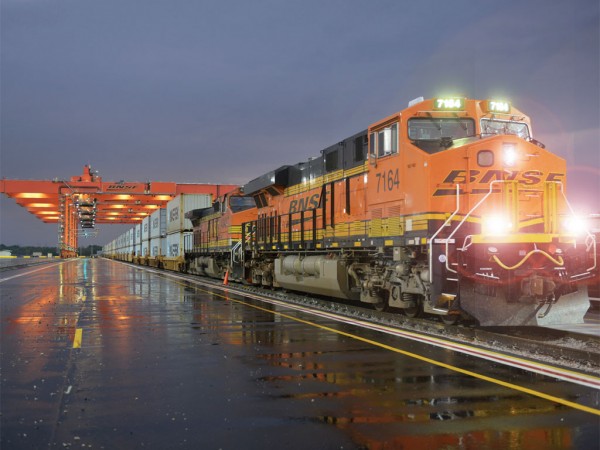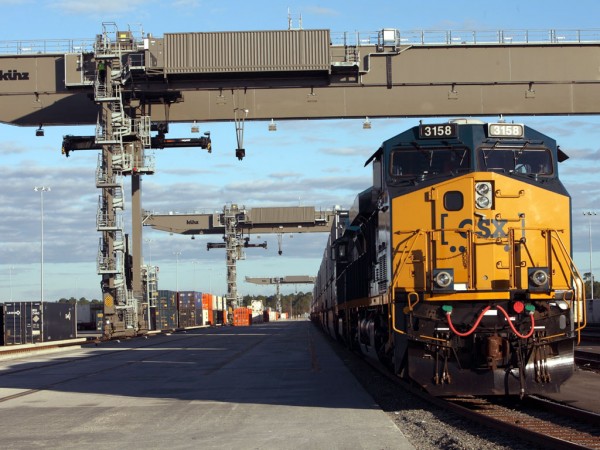On August 5th Union Pacific (UP) Railroad CEO Lance Fritz wrote Martin Oberman, chair of the Surface Transportation Board (STB), assuring him of UP’s efforts to address rail congestion issues that includes connecting West Coast ports to Midwest destinations: “I want to assure you that Union Pacific's tireless efforts and continuous process improvements will yield improved fluidity within the network and clear congestion.”
Fritz noted that recent congestion on the railroads will require supply chain partners working together: “But clearing our network will take some time, and it will require the cooperation of all stakeholders in the supply chain. Critical to clearing the congestion and keeping the network work fluid will be vital non-rail road improvements to the inadequate take away capacity at our ramps that is the root cause of the congestion. We are working hard to help our customers understand the problem and improve their operations…. Though Union Pacific is an integral part of the international supply chain, we capture and execute a finite portion of the transportation pipeline.”
“We discovered the uptick in the container congestion directly correlated to the lack of available space in the customers’ warehouses and our customers’ workforce challenges. The drayage and warehouse operations in major markets have been slow due to outbound drayage processing.”
STB’s Oberman Expresses Concerns About Intermodal Rail Congestion
Fritz and other railroad executives were responding to letters sent them on July 22nd by Oberman.
A that time, Oberman wrote to the chief executives of U.S. Class 1 railroads including the Union Pacific and Burlington Northern Santa Fe railroads, which serve U.S. West Coast ports, expressing “my concerns about significant disruptions within the aspects of the international intermodal supply chain that involve the Class I freight rail network.”
Oberman’s July 22nd letters to the Class 1 railroads summarized complaints to the STB received from shippers:
“I am particularly concerned about significant increases in container congestion at key U.S. terminals, and substantial charges being levied by the railroads for container storage at these terminals.
Specifically, in recent months, the Board has received numerous reports related to the length of time that containers are being held in rail yards, and the sizeable storage fees (“demurrage”) some customers have been required to pay in order to obtain release of containers bearing their shipments.”
Oberman wrote that complaints about Class 1 rail practices to the STB have come from big and small shippers:
“These reports have come from shippers, both large and small, in addition to third party logistics providers. I am particularly troubled about reports that Class I railroads are continuing to impose these charges even in circumstances when the receivers, as a practical matter, have no means to facilitate the release of their containers.”
Finally, Oberman requested information from the Class I railroads: “In order to better understand the magnitude of the current container congestion and the framework for the associated demurrage fees, I am seeking information from each of the Class I railroads regarding policies and practices with respect to the assessment of demurrage fees on intermodal containers.”

UP Responds
In his response, the UP’s Fritz cited responsibilities for congestion of other supply chain partners:
“The intermodal transportation pipeline is driven by the decisions, actions, and capacity of all stakeholders in the pipeline, including steamship lines, shippers, receivers, ports, chassis owners, and drayage providers. All stakeholders must maintain a consistent flow of freight at every step of the process to avoid bottlenecks.”
He went on to cite mistakes made by shippers and receivers:
”Specifically, shippers and receivers are responsible for their decisions to over extend their capacity in shipping and receiving, which congests the supply chain. This over extension is beyond our control… Union Pacific has performed efficiently in out-gating containers from our intermodal ramps.”
Fritz said that the railroad has tried to ease the burden on truckers:
“Union Pacific recognizes the current difficulty for dray carriers to manage efficiently the outbound movement of containers once they are in a stacked location. To ease the stress on our ocean carrier partners, Union Pacific implemented a policy to cap fees at $2,450 in Global 4 (a Chicago UP intermodal facility) when the container is in-stack. Additionally, we have temporarily opened our Global 4 intermodal facility, near Chicago, to private chassis to allow more options for shippers to out-gate their containers. Lastly, Union Pacific has re-opened its Global 3 facility, also near Chicago, to reduce congestion at Global 4…”
Finally, Fritz said: “We also recognize the need for our demurrage and detention fees to be reasonable.”

BNSF’s Farmer Responds
On August 4th BNSF CEO Katie Farmer responded to Oberman’s letter stating that congestion and demurrage charges assessed against rail shippers occur when these shippers do not pick up their containers “on a timely basis.”
She noted, “At any given time we have around 30 trains (holding around 7500 containers) staged for prolonged periods outside our intermodal facilities because there simply is not space in our hub to get those containers unloaded for pickup until the appropriate party coordinates the pickup of the older containers for delivery to processing locations.”
Farmer went on to say that more freight is coming into BNSF facilities than is being picked up and that delays of international containers dwelling in BNSF yards is on the rise:
“For example, while we are transporting and unloading volumes this year at a pace exceeding our peak year of 2018, international containers are dwelling in our yard after unloading nearly 30% longer. The reality is that significantly more freight is coming into BNSF facilities than is being picked up and that simply is not sustainable. “
She said that this has undermined BNSF’s efforts to increase rail fluidity:
“We have continued to take the aggressive measures I shared in July to increase capacity, improve rail performance, and get the most out of our assets. However, the measures we take to maximize efficiency in our handling of cars across our network and within our terminals are largely rendered meaningless if receivers are not ready to pick up those containers from our facility.”
Farmer’s reply to Oberman described equipment shortages of chassis, drivers and warehouse workers as part of the problem:
“As you know, the complexity of the supply chain relies on the performance of numerous entities operating across ports, roadways, railroads, waterways, and shipper and receiver facilities. The challenges being experienced across the entire supply chain that I raised in early July are now well documented and continuing. As even more freight is being put into the global intermodal pipeline, the shortage of chassis, drivers, and labor to support distribution center unloading is causing shipments to back up into rail facilities.”
As a railroad carrying containers between points, BNSF argues that it has relatively few options except to resort to demurrage charges on shippers who fail to pick up their containers:
“As a railroad carrying containers between points where we are not the origination or the final destination of a load, BNSF has relatively few options to maintain the fluidity of our intermodal terminals if containers are not picked up by customers on a timely basis. Unless BNSF can utilize the few tools we have available to incentivize timely pickup – including storage charges when containers are left in our yards beyond free time – rail operations will degrade and ultimately come to a halt. This (STB) Board has recognized the importance of demurrage and storage charges to incentivize the efficient use of rail assets (both equipment and track) by holding rail users accountable when they use those resources beyond a specified period of time.”

CSX’s Foote Responds
In his August 2nd response to Oberman, CSX Corporation President and CEO James Foote wrote that the responsibility for delivering international containers primarily rests with the ocean carriers, described here as “steamship lines”, who bear the prime responsibility for the disposition of freight:
“The movement of an international container from a foreign country to a receiver in the U.S. starts with the fundamental decisions made by a shipper concerning whether to ship now, how much to ship, where to ship, how fast, and which steamship line to use. Each of these decisions have economic consequences that are reasonably foreseeable given the current state of the supply chain. Once these decisions are made, the shipper customarily relies on its selected steamship line to effectively serve as a logistics provider, putting in place all or most of the other segments of the chain. CSX, for example, has a contractual relationship with the steamship line – not with the shipper, receiver, port, chassis owner, or truck drayage provider.”
Foote said some customers do a better job than others of moving containers, but again emphasizes the responsibility of the ocean carriers or “steamship lines”:
“At the Port of NY/NJ, the container is offloaded from the container ship and staged for further inland transport by rail. The steamship line will have already selected an inland rail carrier, in this case CSX, and a rail waybill will have been created with the steamship line as both the freight payer and the shipper. Further customs clearance, physical inspections, and port handling precede the container’s placement on a railcar. After CSX moves the container to the inland rail intermodal terminal chosen by the steamship line, the unit is lifted off the railcar and positioned for pickup, either on a chassis or in a stack easily accessible by lift equipment. Finally, CSX notifies the receiver identified on the waybill that the container is available and a drayage truck, arranged by the receiver or steamship line, removes the container from the rail terminal and delivers it to the receiver’s facility. Here, the receiver coordinates receiving capacity, including warehousing, dock space, and labor, in order to unload the container, so that the empty container and chassis can be used by the next international shipper. Some of our customers do a better job than others of managing a constant flow of containers into and out of our terminals.”
In part, BNSF’s Farmer blames the lack of 24/7 practices within the supply chain, including many container terminals located at U.S. ports, for not moving containers with sufficient speed to ensure fluidity within the supply chain and within railroad operations:
“We do believe that there is enough physical capacity present across the national supply chain to handle the current volumes. The amount of chassis, port and rail terminal capacity, rail equipment, and employee resources is sufficient to handle the current volumes, but only if all parts of the supply chain do their part. Operating 24/7 in all parts of the supply chain, not just rail, would generate substantial capacity immediately.”
Finally, BNSF believes that its imposition of storage fines and demurrage is “reasonable:”
“BNSF strives to ensure that our storage rules are reasonable and designed to incent the behavior needed to support rail terminal fluidity. … we believe our rules are clear and easy to apply, providing transparency around the triggering events for charges and where opportunities exist to avoid charges. It is our practice to ensure that we are only charging a storage fee when the box is actually available for pickup.”

